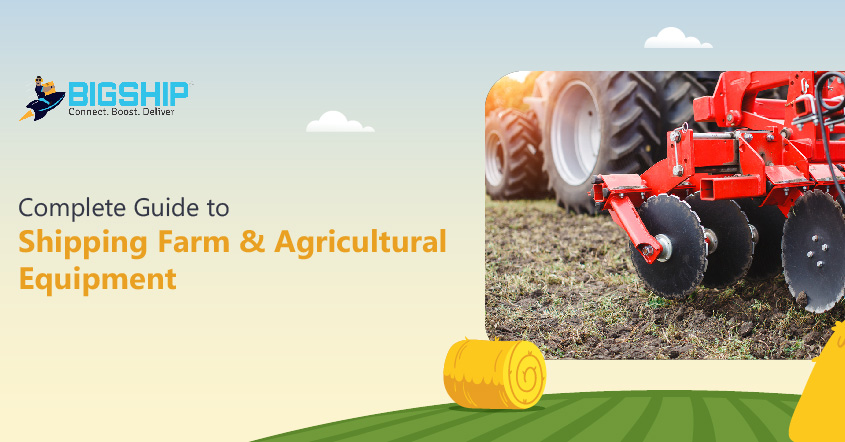Shipping Farm & Agricultural Equipment: A Complete Guide

2. How To Ship Farm & Agricultural Equipment?
3. Choosing the Best Shipping Method For Agricultural Machinery
4. Key Factors Influencing Farm Equipment Shipping Costs
5. Documents Required For Shipping Farm Equipment
6. Additional Tips on Shipping Agricultural & Farm Equipment
7. Conclusion
8. FAQs
As agriculture evolves with advanced technologies, the demand for reliable farm equipment is more important than ever. Shipping agricultural machinery is a crucial aspect of modern farming. It ensures that essential farm equipment like plows, tractors, and irrigation systems reach their destinations safely and efficiently.
This guide provides a detailed overview of the agricultural machinery shipping process. It will help you handle the challenges of moving heavy equipment, whether it’s across the country or internationally.
Why is Shipping Agricultural Machinery Essential?
Shipping agricultural and farm equipment is essential because it enhances farming techniques, boosts productivity, and addresses labor shortages. Agricultural machinery improves land restoration, reduces soil erosion, and makes irrigation more efficient. By transporting this equipment, farms can increase land use and prevent soil degradation.
Agricultural Mechanization replaces traditional farming methods and leads to higher crop yields and increased profits. With labor shortages affecting rural areas, machinery reduces the need for manual labor. This further makes farming more efficient. Moreover, effective machinery shipping allows for better land utilization and improved crop variety, ultimately raising farm income and supporting commercial success in agriculture.
How To Ship Farm & Agricultural Equipment?
The process of shipping farm and agricultural equipment involves a few key steps to ensure that everything arrives safely and on time. Here’s a simple guide to help you through the process.
Determine the Specifications of Farm Equipment: Start by measuring the weight and dimensions of your equipment. Also, identify whether it’s a vehicle, machinery, or another type of heavy equipment to ensure proper handling during its shipping.
Compare Shipping Rates & Select the Right Carrier: Now research the cost of farm equipment shipping from various carriers. Compare their prices and services to choose the one that best fits your needs for shipping agricultural machinery.
Prepare the Equipment for Shipping: Clean and disassemble the equipment if needed. Also, document any existing damage to set a baseline for any potential issues during transit. Lastly, proper packaging is crucial to protect your equipment during the shipping process.
Secure Permits and Insurance: Gather necessary documents such as a Commercial Invoice, bill of lading, import/export permits, LUT, SLI, etc. Also, consider obtaining freight insurance to cover any potential damage during the shipment process.
Track & Monitor Shipment: Use tracking services provided by many carriers to keep an eye on your shipment’s progress. This ensures you stay informed until your equipment reaches its destination.
Choosing the Best Shipping Method For Agricultural Machinery
Selecting the best shipping method for farm equipment is essential to ensuring safe, efficient, and cost-effective transportation. Various options are available depending on the equipment’s size, weight, and destination. These are mentioned below:
Road Transportation: This is a common and economical choice for domestic farm equipment shipping. It’s suitable for transporting heavy agricultural machinery using vehicles like flatbed trucks, tractor trailers, semi-trailers, and tanker trucks. Road transportation offers flexibility and accessibility which makes it ideal for shorter distances or within the same country. In road transportation, you can choose from LTL and FTL services, whichever is suitable for you. LTL means sharing a truck with others, which is cost-effective for smaller loads. FTL means reserving a whole truck just for your shipment, which is best for larger loads.
Ocean Freight: When shipping larger or heavier agricultural machinery across international borders or over long distances, ocean freight is a reliable option. Equipment can be transported in containers or as rolling cargo using Ro-Ro (Roll-On/Roll-Off) vessels. Although this method is cost-effective due to economies of scale, it take longer time to deliver, which should be considered when planning machinery shipping.
Air Freight: Air freight is the fastest but most expensive option for farm equipment shipping. It’s ideal for time-sensitive shipments, or when minimizing transit time is critical. While air freight ensures quick delivery, the higher costs make it suitable primarily for valuable or urgent agricultural machinery.
Key Factors Influencing Farm Equipment Shipping Costs
Several factors play key roles in influencing agricultural and farm equipment costs. Some of the main factors include size and weight, transportation distance, seasonal demand, urgency, special handling needs, and type of equipment. Let’s understand each of these factors in detail.
Equipment Size and Weight: The size and weight of farm equipment have an important role to play in determining the cost of transportation. Larger and heavier machinery requires more space on the trailer, leading to higher shipping expenses. For instance, agricultural machinery like tractors may need less space compared to a large combine harvester, which may occupy an entire trailer. Additionally, shipping heavy farm equipment results in increased fuel consumption, further driving up costs.
Transportation Distance: The distance over which farm equipment needs to be transported is another major factor influencing shipping costs. The further the distance, the higher the expense, as longer trips incur greater fuel consumption and labor costs. Whether you’re moving agricultural machinery within a region or across the country, the distance will directly impact your budget for farm equipment shipping.
Seasonal Demand: The time of the year can significantly impact the cost of shipping agricultural machinery and equipment. During the harvest season, the demand for farm equipment shipping services surges, causing transportation rates to rise sharply. Conversely, once the harvest season ends, the demand for these services declines, often resulting in lower shipping rates.
Urgency of Delivery: The urgency of the shipment can also influence the cost. If you require expedited transport services to ensure faster delivery, this will come with a premium price. Expedited shipping is ideal for time-sensitive situations when you need to deliver farm equipment within a time frame to its destination.
Special Handling Needs: If your farm equipment requires special handling, such as extra protection or specific care during transit, these needs will add to the shipping cost. For instance, machinery that is delicate needs customized packaging or specialized transport equipment which leads to higher expenses.
Type of Equipment: Some machinery, like tractors and lawn mowers, are relatively easy to transport because they are more compact and don’t require disassembly. However, larger and more complex machines, such as combine harvesters, often need to be partially dismantled before shipping. This process requires additional labor and time, which can increase the overall cost of transport.
Documents Required For Shipping Farm Equipment
Proper documentation is a mandatory requirement when shipping farm equipment domestically within India or internationally. Below is a guide to the necessary documents required for both domestic and international shipping.
Domestic Shipping
When shipping farm equipment within India, certain key documents are required to comply with legal regulations and ensure a seamless transportation process. These documents are mentioned below.
GST Invoice: A GST invoice is a mandatory document when shipping farm equipment within India. This invoice serves as proof of the transaction and contains important details such as the description of the goods, their quantity, the buyer and seller’s GSTIN (Goods and Services Tax Identification Number), and the amount of GST charged.
E-way Bill: An E-way bill is another essential document for domestic shipping. It is an electronic document generated on the GST portal that must be carried when transporting goods worth over Rs. 50,000. The E-way bill includes details of the goods, the consignor, the consignee, and the transporter. It helps authorities track the movement of goods and ensures that the transport of farm equipment complies with GST regulations.
International Shipping
When shipping agricultural or farm equipment internationally, additional documentation is required to comply with customs regulations and international trade laws. These documents help facilitate smooth export processes and avoid delays.
IEC Certificate: The Importer Exporter Code (IEC) is a unique identification number issued by India’s trade authorities to businesses involved in international trade. This code is necessary for customs clearance, bank transactions, and other trade-related activities. Without an IEC, a business cannot legally export or import goods.
AD Code: The Authorised Dealer Code is a 14-digit number issued by a bank where the exporter has an account. This code is essential for customs clearance and must be registered with the port from which the goods are being shipped. If an exporter uses multiple ports, each port must have its own registered AD code. This code ensures that all international financial transactions are properly monitored and reported.
Goods and Services Tax (GST): For international shipments, GST on exported goods is generally exempt since exports are considered zero-rated supplies. However, it is important to maintain accurate documentation to prove the export and ensure compliance with tax laws.
Invoice and Packaging List: The invoice and packing list are critical documents in international shipping. The invoice outlines the transaction details, including the goods sold, their quantities, and the agreed prices. The packing list provides specific details about the contents of the shipment, including weight, dimensions, and packaging information. These documents are essential for customs clearance and help in tracking the shipment throughout its journey.
Company PAN Card: A Company PAN card is a 10-digit unique identification number issued by the Income Tax Department to businesses. This PAN card is essential for foreign exchange transactions, receiving payments from international entities, and managing financial operations.
LUT: A Letter of Undertaking is a document that exporters need to submit to claim a GST refund on exported goods. It acts as a guarantee provided by the exporter’s bank to the customs authorities, ensuring that the goods will be exported without the payment of IGST.
SLI: The Shipper’s Letter of Instruction (SLI) is a document issued by the exporter to the logistics partner. It contains specific instructions about the transportation and documentation requirements. The SLI authorizes the logistics partner to arrange for transportation and handle all customs-related paperwork, thus, ensuring that the shipment is processed efficiently.
Additional Tips on Shipping Agricultural & Farm Equipment
Farm equipment shipping requires careful attention to detail to ensure everything goes smoothly. Here are some additional tips to help make the process more efficient and secure.
1. Make sure the shipping company has the proper licenses and insurance to handle your specific type of cargo. This ensures that your equipment is covered in case of any issues during transit.
2. If your agricultural machinery needs special handling or permits, select a shipping company experienced in managing these requirements. Their expertise will help manage any complex regulations or needs.
3. Prepare for the loading and unloading of the equipment. Clear the loading area of any obstacles to prevent accidents. Also, ensure there’s enough space for the equipment and use ramps or loading docks if necessary.
Conclusion
Efficient farm equipment shipping helps in maintaining productivity in modern agriculture. Whether moving agricultural machinery domestically or internationally, choosing the right shipping method and preparing equipment carefully can save time and reduce costs. By understanding the factors that influence shipping costs and ensuring all necessary documents are in place, you can simplify the process of machinery shipping effectively.
Farm Equipment Shipping: FAQs
Ques: What equipment are counted as agriculture and farming equipment?
Ans: Equipment like tractors, cultivators, plows, cultivators, seeders, sprayers, harvesters, irrigation systems, etc., are counted as agricultural equipment.
Ques: How should I get my agricultural equipment ready for shipping?
Ans: Follow the steps given below to prepare your agricultural equipment for shipping:
- Determine Specifications: Measure weight and dimensions, identify the equipment type.
- Compare Rates & Choose Carrier: Research and compare shipping costs and services.
- Prepare Equipment: Clean, disassemble if needed, document any damage, and package properly.
- Secure Permits & Insurance: Obtain necessary documents and consider insurance.
- Track Shipment: Use tracking services to monitor progress until delivery.
Ques: Is it possible to ship agricultural equipment internationally?
Ans: Yes, you can ship agricultural equipment internationally. However, rules, customs, and costs can vary by destination.
Ques: Are there size or weight limits for shipping agricultural equipment?
Ans: Yes, size and weight limits depend on the shipping method and carrier. You can always check with the shipping company for their specific guidelines.
Ques: What are the shipping methods for agricultural equipment?
Ans: Three main shipping methods for agricultural equipment are:
- Road Transportation: It is cost-effective for domestic shipping. Flatbed trucks and trailers are used for transporting agricultural and farm equipment.
- Ocean Freight: This method is ideal for large or heavy equipment over long distances or internationally, with cost savings but longer delivery times.
- Air Freight: It is fastest but most expensive, best for urgent or high-value shipments.





